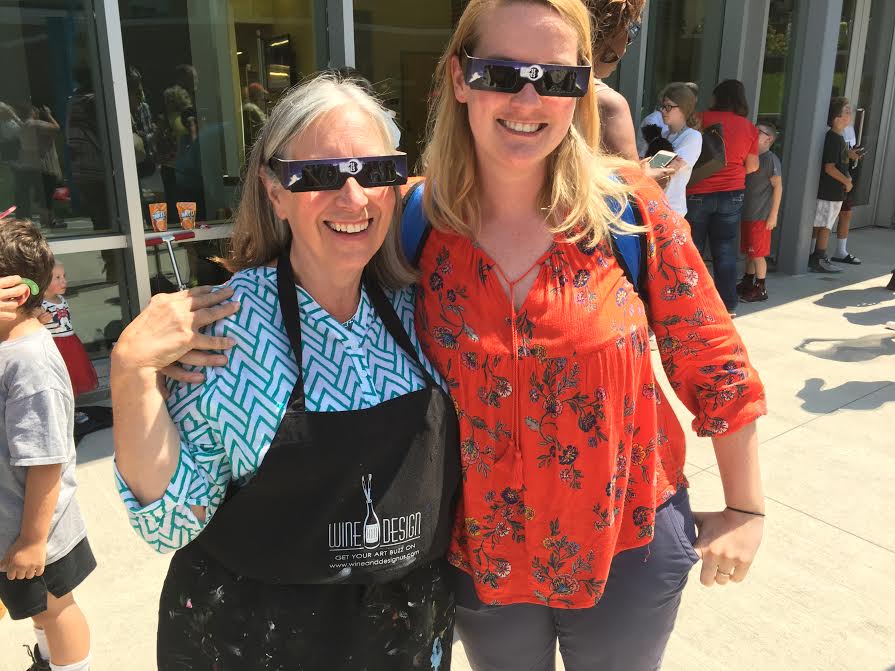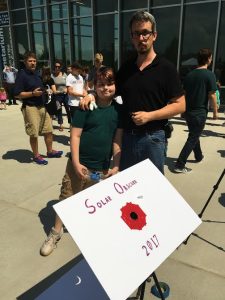Alexa Doiron
communitynews@ourvalley.org

Over 1,000 members of the community came out to Radford University on Monday to view the first almost total eclipse in 37 years. Skipp Watts from the university’s geology department was using an unmanned aerial vehicle, or drone, which is used by the department to do geohazard investigations.
Radford University’s Physics Department held an eclipse viewing for the community that brought out over 1,000 people on Monday.
RU supplied special eclipse viewing glasses for those in attendance, but ran out after the first few hours of the party. However, many members in the crowd shared glasses with those who hadn’t gotten them on time so everyone was able to view the eclipse safely.
As the sky darkened over the hours, the university held the viewing party for most of the day and included activities for all ages. Children were able to paint space-themed pictures and other activities that were put on in partnership with the Children’s Museum of Blacksburg and the Radford City Public Library.

Adults were able to watch videos about the eclipse and hear a live stream chat with solar researchers. The event was bigger than the department may have expected said one viewer, Marty Elder. However, the crowd came together to celebrate this event and enjoy the activities.
“It’s cool to see so many children out and parents bringing them out to share this opportunity that they may not have for a while,” Elder said.
Many people brought their own eclipse viewing tools, such as Joseph Rogers and his son Zachary who built their own solar obscura. This is a DIY solar projector, which is said to be one of the safest ways to view the eclipse. This natural optical phenomenon that occurs when an image of a scene at the other side of a screen is projected through a small hole in that screen as a reversed and inverted image on a surface opposite to the opening.
Skip Watts from the Radford University Geology Department was also out in front of the science building using an unmanned aerial vehicle, also known as a drone, which is used by the department to do geohazard investigations.
 The eclipse crossed the nation on Monday; beginning on the West coast as NASA and other organizations live streamed the event. The moon began covering the sun early on in the day, but the peak of the event Snapchat and Facebook participated in the event with social media filters and many people posted blurry photos taken from phones behind eclipse glasses. The event marked a day for history as the nation stopped to view this astronomical event.
The eclipse crossed the nation on Monday; beginning on the West coast as NASA and other organizations live streamed the event. The moon began covering the sun early on in the day, but the peak of the event Snapchat and Facebook participated in the event with social media filters and many people posted blurry photos taken from phones behind eclipse glasses. The event marked a day for history as the nation stopped to view this astronomical event.
“Eclipses happen on a regular basis but usually not where you’re going to live. So when it does happen, it’s good to take advantage of it,” Brett Taylor, a professor in the RU Physics Department said.
A video from the last solar eclipse, reported on by ABC’s Frank Reynolds in 1979, circulated the Internet yesterday. The last words of his video resonated with many as they reflected on the state of the nation.
“So that’s it, the last solar eclipse to be seen on this continent…until August 21, 2017, that’s 38 years from now,” Reynolds said. “And may the shadow of the moon fall on a world at peace.”
There are many who missed the event, however. Those who were unable to see the eclipse on Monday don’t have to wait long for the next one which will take place on April 8, 2024 in North America.

